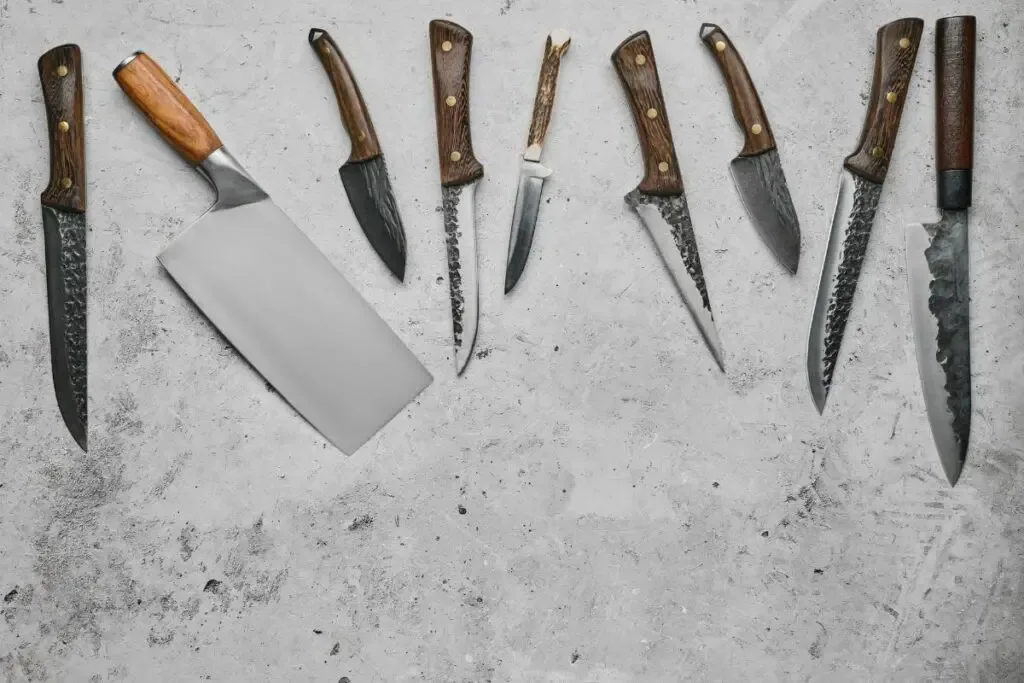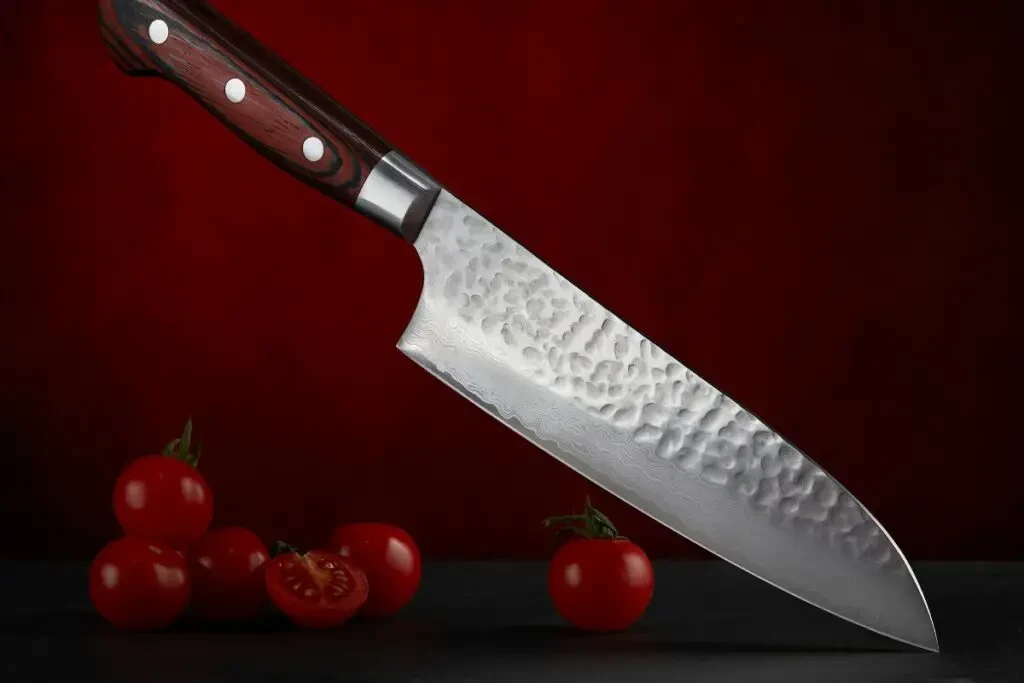As an Amazon Associate, we earn from qualifying purchases with no additional costs for you.
Grooves, dents, and other textures are sometimes featured on Japanese and other kitchen knives. These characteristics have a function other than simple aesthetics of creative license on the part of the knifemaker. What role do dents and grooves on a knife’s blade fulfill in its function?
There are 3 main reasons that Japanese knives have grooves or dents. These features on the blade help reduce friction as the knife slices through the ingredients and break the surface tension between the blade and the food, allowing it to slide off the knife. The final reason is aesthetics.
If you have seen kitchen knives that have grooves or dents on the blade, you may wonder if these features have any usefulness or whether it is only a design feature intended to give some flair to the knife. The reality is that it is both for form and function and can help improve the knife’s effectiveness.
If you are interested in checking out the best Japanese knives (made by Hayate Yoshihiro) we recommend and use, you can find them by clicking here (Amazon link).

Why Do Japanese Knives Have Grooves?
Recent times have seen elliptical grooves ground into one or both sides of the knife. Typically, these grooves are positioned vertically, fairly close to the knife’s cutting edge, and extending to almost the midline of the blade.
These grooves are sometimes referred to as scallops in the blade or a kullenschliff or Granton edge. These hollows that are ground into the blade lend an intriguing visual appeal to the knife and also serve a purpose.
The first advantage of these grooves is to reduce friction between the knife blade and the ingredient being sliced.
Only the raised sections of the blade on the groove edges will be in contact with the ingredient being cut rather than the full flat surface of the blade.
This reduces the blade’s surface area that is in contact with the food being cut, which, in turn, reduces the amount of friction between the food and the blade.
Reduced friction allows the knife to pass through the food much easier, allowing the sharp edge to cut through the ingredients instead of being pushed through by the knife user.
Enabling the knife to pass through the food with less pressure makes it safer to use the knife and prevents the bruising or squashing of the ingredients being cut.
The grooves’ second function on the knife’s blade is to break the surface tension when slicing through flat or moist ingredients.
Flat and moist ingredients tend to create a suction between the food and the knife blade, which causes the food to grip or stick to the blade.
You can experience this phenomenon when slicing through potatoes, where the piece sliced off does not fall away from the blade but sticks to it.
The potato’s moisture content and flat surface create a surface tension between it and the blade, sucking it onto it.
A similar scenario is slicing through a raw steak. The damp, flat side of the steak sticks to the blade because of surface tension, making it difficult for the knife to pass through the meat. The sliced section also adheres to the blade after it has been cut.
The scalloped grooves in the blade create air pockets between the ingredient and the blade, preventing the surface tension of these ingredients from pulling them onto the blade’s surface. The grooves allow the sliced piece to fall away from the blade once the cut is complete.
The final reason these grooves are created on a blade is that they improve the attractiveness of the blade. The grooves break up the otherwise flat surface of the steel, improving the overall aesthetics of the blade.
BTW: If you want to know more about Japanese and other knives and their sharpening, check out the books listed above. These books are recommended by professional sharpeners and knife makers (Amazon links):
- Japanese Kitchen Knives: Essential Techniques and Recipes
- The Knifenerd Guide to Japanese Knives
- Knife: The Culture, Craft, and Cult of the Cook’s Knife
- Sharp: The Definitive Introduction to Knives, Sharpening, and Cutting Techniques, with Recipes from Great Chefs
TIP: A bolster on a knife performs a function in the use and safety of the knife. Do Japanese knives have bolster? Find out the answer if knives need a bolster and if Japanese knives have a bolster too, in the articles below:
Do Knives Need A Bolster? Here’s The Explanation
Do Japanese Knives Have A Bolster? Here’s The Answer
Do All Japanese Knives Have Grooves?

Not all Japanese knives have these grooves or Granton edges on the blade. The most common Japanese knife to include these grooves is the Santoku.
The Santoku, literally translated, means the “3 uses knife,” indicating it is intended to be a multipurpose knife. Because of the multipurpose nature of these knives, it makes sense that the Santoku should have this feature.
The blade shape of a Santoku is also conducive to having these grooves cover a large section of the length of the blade.
The grooves’ popularity in these knives led to many Western knives adopting the same features in their design to appeal to a wider market, even if the use of the knife does not warrant them as a useful feature. The visual appeal is what sells the knife.
It is not common for other Japanese knives to have grooves along the blade for the purposes we have mentioned, but other Japanese knives have different features that perform the same function.
Single bevel Japanese knives have a slight hollow grind on the flat side of the blade, which acts to reduce friction and break the surface tension between the blade and the food.
The hollow grind is the greatest gap between the food and the blade to achieve these purposes. The hollow grind is often very subtle, making it difficult to see if you are not looking for it.
TIP: Santoku is one of the best Japanese knives for chopping vegetables. Do you know what the others are? Check them out in the article below:
The 8 Best Japanese Knives For Chopping Vegetables
Why Do Japanese Knives Have Dents?

Some Japanese knives have dents detailed on both sides of the blade. These dents are created in the hot steel during the forging process by beating the steel with a rounded or peening hammer.
When the hot metal is hit with the rounded part of the hammer, it leaves small dents or depressions on the surface of the steel. In knives where a smooth finish is desired on the blade, these dents are ground out to produce a flat blade.
In other cases, the dents are left on the blade, and only the small section of the cutting edge is ground smooth, leaving the dents on the majority of the blade’s surface.
These dents in the knife’s blade perform the same roles of friction reduction and breaking surface tension with the food, but the visual effect is very different from the Granton edge or grooved blade.
Although the dents on the blade perform the same function as grooves, the hammer blows give a more rustic, work-hardened look to the knife.
The steel is often acid-etched or left with some forge scale on the blade to darken the blade and accentuate the visual effect of the dents.
FAQ
Q: Why do Japanese knives have grooves or dents in them?
A: Japanese knives often feature grooves or dents to reduce friction between the knife and the food being cut, allowing for smoother slicing. These features also prevent food from sticking to the blade and enhance the aesthetic appeal of the knife.
Q: Are the grooves in Japanese knives purely for aesthetic purposes?
A: While the grooves do add to the visual appeal of the knife, they also serve functional purposes, such as reducing friction and preventing food from sticking to the blade, making the cutting process more efficient and enjoyable.
Q: Do all Japanese knives feature grooves or dents?
A: No, not all Japanese knives have grooves or dents. It is most commonly found in Santoku knives, which are designed to be multipurpose. Other Japanese knives may have different features that perform similar functions.
Q: How do the grooves in Japanese knives enhance the cutting experience?
A: The grooves reduce the surface area of the blade in contact with the food, minimizing friction and allowing the knife to glide through ingredients with less resistance. This makes it safer to use the knife and prevents ingredients from being bruised or squashed while cutting.
Q: Can I find these grooves in knives from other countries?
A: Yes, the popularity of grooves in Japanese knives has led to many Western knives adopting similar features in their design to appeal to a wider market, even if the purpose of the knife does not require the grooves.
Q: How do I care for a Japanese knife with grooves or dents?
A: Caring for Japanese knives with grooves or dents involves regular sharpening, proper cleaning, and storage. Avoid using abrasive materials when cleaning to maintain the integrity of the grooves and dents.
Q: Are Japanese knives with grooves or dents more expensive?
A: The presence of grooves or dents does not necessarily make Japanese knives more expensive. The price is usually determined by the quality of materials used, craftsmanship, brand, and other features of the knife.
Q: Where can I buy authentic Japanese knives with grooves?
A: Authentic Japanese knives with grooves can be purchased from reputable online retailers, specialized kitchenware stores, or directly from manufacturers. Always buy Japanese knives from trusted sources to guarantee the authenticity and quality of the knife.
Q: Can the grooves or dents wear out or diminish over time?
A: With proper care and maintenance, the grooves or dents in Japanese knives should remain intact. However, improper sharpening techniques or excessive wear and tear can potentially damage these features.
Q: Are there different types of grooves or dents in Japanese knives?
A: Yes, there are variations in the design of grooves and dents, each serving a specific purpose and adding a unique visual appeal to the knife. Some knives have scalloped grooves, while others feature dents created during the forging process.
Q: How do I sharpen Japanese knives with grooves or dents without damaging them?
A: When sharpening Japanese knives with grooves or dents, it’s crucial to use the correct sharpening technique and tools to avoid damaging the features. Use a whetstone and follow the angle recommended for your specific knife. Sharpen the blade gently, focusing on the cutting edge and avoiding excessive pressure on the grooved or dented areas.
Q: Is there any difference in the quality of cut between a knife with grooves and one without?
A: The presence of grooves can enhance the cutting experience by reducing friction and preventing food from sticking to the blade, allowing for more precise cuts. The quality of the cut also depends on other factors, such as the sharpness of the blade, the technique used, and the type of food being cut. A well-sharpened knife without grooves can also achieve high-quality cuts if used correctly.
Conclusion
Grooves, scallops, a kullenschliff or Granton edge, and dents in the blade intentionally left from the forging process increase the knife’s beauty and offer useful additions to the knife’s performance.
These features on the blade interrupt the smooth surface of the steel, reducing the friction between the knife and the ingredients, allowing the knife to cut smoothly with less resistance.
They also break the surface tension between the knife blade and the food so that the food does not stick to the blade.
These textures on the blade also intrigue the eye and improve the overall visual appeal of the knife, persuading more people to buy these knives simply because they look so cool!
TIP: Japanese knives are quite expensive, so it is always good to know how to care about them properly. Find out all you need to know in the article below:
How To Care For Japanese Knives: The Complete Guide
